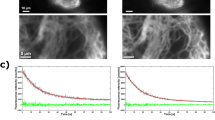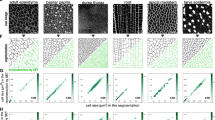Abstract
Cell biology heavily relies on the behavior of fibrillar structures, such as the cytoskeleton, yet the analysis of their behavior in tissues often remains qualitative. Image analysis tools have been developed to quantify this behavior, but they often involve an image pre-processing stage that may bias the output and/or they require specific software. Here we describe FibrilTool, an ImageJ plug-in based on the concept of nematic tensor, which can provide a quantitative description of the anisotropy of fiber arrays and their average orientation in cells, directly from raw images obtained by any form of microscopy. FibrilTool has been validated on microtubules, actin and cellulose microfibrils, but it may also help analyze other fibrillar structures, such as collagen, or the texture of various materials. The tool is ImageJ-based, and it is therefore freely accessible to the scientific community and does not require specific computational setup. The tool provides the average orientation and anisotropy of fiber arrays in a given region of interest (ROI) in a few seconds.
This is a preview of subscription content, access via your institution
Access options
Subscribe to this journal
Receive 12 print issues and online access
$259.00 per year
only $21.58 per issue
Buy this article
- Purchase on Springer Link
- Instant access to full article PDF
Prices may be subject to local taxes which are calculated during checkout



Similar content being viewed by others
References
Lippincott-Schwartz, J. & Manley, S. Putting super-resolution fluorescence microscopy to work. Nat. Methods 6, 21–23 (2009).
Gerlich, D., Mattes, J. & Eils, R. Quantitative motion analysis and visualization of cellular structures. Methods 29, 3–13 (2003).
Axelrod, D. Total internal reflection fluorescence microscopy in cell biology. Traffic 2, 764–774 (2001).
Green, P.B. Multinet growth in the cell wall of Nitella. J. Biophys. Biochem. Cytol. 7, 289–296 (1960).
Tower, T.T., Neidert, M.R. & Tranquillo, R.T. Fiber alignment imaging during mechanical testing of soft tissues. Ann. Biomed. Eng. 30, 1221–1233 (2002).
Sander, E.A., Stylianopoulos, T., Tranquillo, R.T. & Barocas, V.H. Image-based multiscale modeling predicts tissue-level and network-level fiber reorganization in stretched cell-compacted collagen gels. Proc. Natl. Acad. Sci. USA 106, 17675–17680 (2009).
Pijanka, J.K. et al. Quantitative mapping of collagen fiber orientation in non-glaucoma and glaucoma posterior human sclerae. Invest. Ophthalmol. Vis. Sci. 53, 5258–5270 (2012).
Yi, Q. & Coppolino, M.G. Automated classification and quantification of F-actin-containing ruffles in confocal micrographs. Biotechniques 40, 745–746, 748, 750 passim (2006).
Higaki, T., Kutsuna, N., Sano, T., Kondo, N. & Hasezawa, S. Quantification and cluster analysis of actin cytoskeletal structures in plant cells: role of actin bundling in stomatal movement during diurnal cycles in Arabidopsis guard cells. Plant. J. 61, 156–165 (2010).
Jacques, E. et al. MicroFilament Analyzer, an image analysis tool for quantifying fibrillar orientation, reveals changes in microtubule organization during gravitropism. Plant. J. 74, 1045–1058 (2013).
Rubbens, M.P. et al. Quantification of the temporal evolution of collagen orientation in mechanically conditioned engineered cardiovascular tissues. Ann. Biomed. Eng. 37, 1263–1272 (2009).
Sander, E.A. & Barocas, V.H. Comparison of 2D fiber network orientation measurement methods. J. Biomed. Mater. Res. A 88, 322–331 (2009).
Schriefl, A.J., Wolinski, H., Regitnig, P., Kohlwein, S.D. & Holzapfel, G.A. An automated approach for three-dimensional quantification of fibrillar structures in optically cleared soft biological tissues. J. R. Soc. Interface 10, 20120760 (2013).
Karlon, W.J., Covell, J.W., McCulloch, A.D., Hunter, J.J. & Omens, J.H. Automated measurement of myofiber disarray in transgenic mice with ventricular expression of ras. Anatomical Record 252, 612–625 (1998).
Uyttewaal, M. et al. Mechanical stress acts via Katanin to amplify differences in growth rate between adjacent cells in Arabidopsis. Cell 149, 439–451 (2012).
Lucas, J.R. & Shaw, S.L. MAP65-1 and MAP65-2 promote cell proliferation and axial growth in Arabidopsis roots. Plant J. 71, 454–463 (2012).
Martin, A.C., Kaschube, M. & Wieschaus, E.F. Pulsed contractions of an actin-myosin network drive apical constriction. Nature 457, 495–499 (2009).
Burian, A. et al. A correlative microscopy approach relates microtubule behavior, local organ geometry, and cell growth at the Arabidopsis shoot apical meristem. J. Exp. Bot. 64, 5753–5767 (2013).
Acknowledgements
This research was supported by a bilateral grant from Institut National de la Recherche Agronomique (INRA), France; by the Ministry of Science and Higher Education, Poland; by the MAESTRO research grant no. 2011/02/A/NZ3/00079 from the National Science Centre, Poland; and by a grant from Agence Nationale de la Recherche ANR-10-BLAN-1516 'Mechastem'. We thank Platim (UMS 3444 Biosciences Gerland-Lyon Sud) for help with imaging.
Author information
Authors and Affiliations
Contributions
The protocol was initiated and first tested by A. Boudaoud, M.U. and O.H. A. Boudaoud designed the ImageJ macros and supervised the formulation of the protocol. A. Burian, D.B.-W., R.W. and D.K. obtained images of fibrillar structures and used them to further test the macros. A. Boudaoud and O.H. wrote the manuscript with input from the other authors.
Corresponding author
Ethics declarations
Competing interests
The authors declare no competing financial interests.
Integrated supplementary information
Supplementary Figure 1 Validation of FibrilTool with artificial images.
a-d. Examples of artificial images (372x372 pixels) obtained by generating 50 random segments (black segments, width 2 pixels) with (a,b) or with no (c,d) directional bias; the images in (a,c) were “degraded” by applying a Gaussian blur of radius 5 pixels (b,d); the theoretical orientation and anisotropy score can be computed directly from the distribution of segments, while the output of FibrilTool is shown in blue. e,f. Results of the analysis of a set of 10x3 such images with FibrilTool: raw images (continuous lines), moderately degraded images (blur of radius 3, dashed lines), and degraded images (blur of radius 5, dot-dashed lines). Data are plotted as a function of the theoretical anisotropy score: anisotropy score measured with FibrilTool (e); difference in degrees between orientation measured with FibrilTool and theoretical orientation (f).
Supplementary information
Supplementary Figure 1
Validation of FibrilTool with artificial images. (PDF 370 kb)
Supplementary Table 1
Sample excel file that can be used to copy-paste the contents of the Log file. (XLS 27 kb)
Supplementary Data 1
Source file of FibrilTool. (TXT 6 kb)
Supplementary Data 2
Source file of the DirectionPrinting macro. (TXT 0 kb)
Rights and permissions
About this article
Cite this article
Boudaoud, A., Burian, A., Borowska-Wykręt, D. et al. FibrilTool, an ImageJ plug-in to quantify fibrillar structures in raw microscopy images. Nat Protoc 9, 457–463 (2014). https://doi.org/10.1038/nprot.2014.024
Published:
Issue Date:
DOI: https://doi.org/10.1038/nprot.2014.024
This article is cited by
-
Spermidine Modulates Pollen Tube Growth by Affecting the Factors Involved in Pollen Tube Elongation
Journal of Plant Growth Regulation (2024)
-
Differences and similarities in biophysical and biological characteristics between U87 MG glioblastoma and astrocyte cells
Histochemistry and Cell Biology (2024)
-
Blockade of TGF-β signalling alleviates human adipose stem cell senescence induced by native ECM in obesity visceral white adipose tissue
Stem Cell Research & Therapy (2023)
-
High-throughput characterization of cortical microtubule arrays response to anisotropic tensile stress
BMC Biology (2023)
-
Polarity and chirality control of an active fluid by passive nematic defects
Nature Materials (2023)
Comments
By submitting a comment you agree to abide by our Terms and Community Guidelines. If you find something abusive or that does not comply with our terms or guidelines please flag it as inappropriate.



